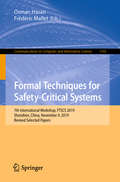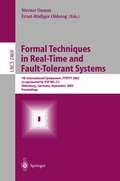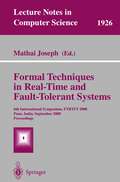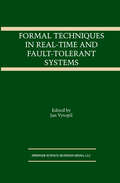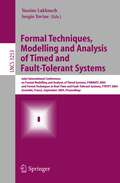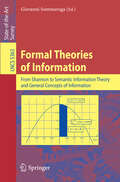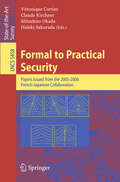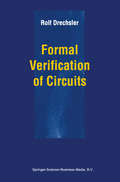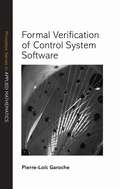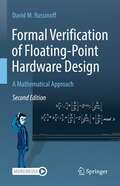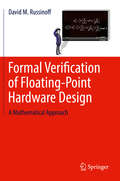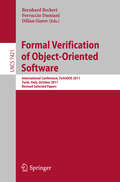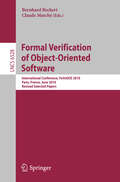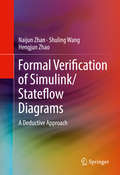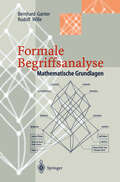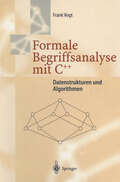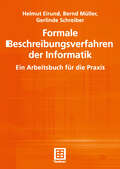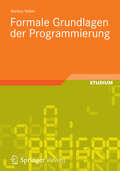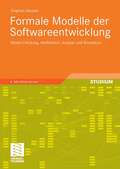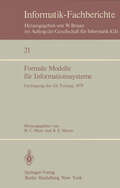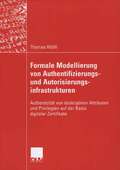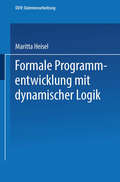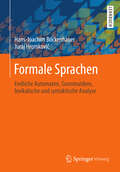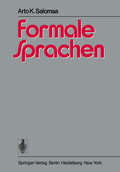- Table View
- List View
Formal Techniques for Safety-Critical Systems: 7th International Workshop, FTSCS 2019, Shenzhen, China, November 9, 2019, Revised Selected Papers (Communications in Computer and Information Science #1165)
by Osman Hasan Frédéric MalletThis book constitutes the refereed proceedings of the 7th International Workshop on Formal Techniques for Safety-Critical Systems, FTSCS 2019, held in Shenzhen, China, in November 2019.The 6 revised full papers presented were carefully reviewed and selected from 17 submissions. Additionally, the volume presents 1 invited paper, 1 tool paper, and 1 work in progrerss. The papers are focused on the topics of the use of formal methods for analyzing safety-critical systems; methods, techniques and tools to support automated analysis, certication, debugging, etc., of complex safety/QoS-critical systems; analysis methods that address the limitations of formal methods in industry (usability, scalability, etc.); formal analysis support for modeling languages used in industry; code generation from validated models.
Formal Techniques in Real-Time and Fault-Tolerant Systems: 7th International Symposium, FTRTFT 2002, Co-sponsored by IFIP WG 2.2, Oldenburg, Germany, September 9-12, 2002. Proceedings (Lecture Notes in Computer Science #2469)
by Werner Damm Ernst-Rüdiger OlderogThis volume contains the proceedings of FTRTFT 2002, the International S- posium on Formal Techniques in Real-Time and Fault-Tolerant Systems, held at the University of Oldenburg, Germany, 9–12 September 2002. This sym- sium was the seventh in a series of FTRTFT symposia devoted to problems and solutions in safe system design. The previous symposia took place in Warwick 1990, Nijmegen 1992, Lub ¨ eck 1994, Uppsala 1996, Lyngby 1998, and Pune 2000. Proceedings of these symposia were published as volumes 331, 571, 863, 1135, 1486, and 1926 in the LNCS series by Springer-Verlag. This year the sym- sium was co-sponsored by IFIP Working Group 2.2 on Formal Description of Programming Concepts. The symposium presented advances in the development and use of formal techniques in the design of real-time, hybrid, fault-tolerant embedded systems, covering all stages from requirements analysis to hardware and/or software - plementation. Particular emphasis was placed on UML-based development of real-time systems. Through invited presentations, links between the dependable systems and formal methods research communities were strengthened. With the increasing use of such formal techniques in industrial settings, the conference aimed at stimulating cross-fertilization between challenges in industrial usages of formal methods and advanced research. Inresponsetothecallforpapers,39submissionswerereceived.Eachsubm- sion was reviewed by four program committee members assisted by additional referees. At the end of the reviewing process, the program committee accepted 17 papers for presentation at the symposium.
Formal Techniques in Real-Time and Fault-Tolerant Systems: 6th International Symposium, FTRTFT 2000 Pune, India, September 20-22, 2000 Proceedings (Lecture Notes in Computer Science #1926)
by Mathai JosephFormal Techniques in Real-Time and Fault-Tolerant Systems (The Springer International Series in Engineering and Computer Science #221)
by Jan VytopilFormal Techniques in Real-Time and Fault-Tolerant Systems focuses on the state of the art in formal specification, development and verification of fault-tolerant computing systems. The term `fault-tolerance' refers to a system having properties which enable it to deliver its specified function despite (certain) faults of its subsystem. Fault-tolerance is achieved by adding extra hardware and/or software which corrects the effects of faults. In this sense, a system can be called fault-tolerant if it can be proved that the resulting (extended) system under some model of reliability meets the reliability requirements. The main theme of Formal Techniques in Real-Time and Fault-Tolerant Systems can be formulated as follows: how do the specification, development and verification of conventional and fault-tolerant systems differ? How do the notations, methodology and tools used in design and development of fault-tolerant and conventional systems differ? Formal Techniques in Real-Time and Fault-Tolerant Systems is divided into two parts. The chapters in Part One set the stage for what follows by defining the basic notions and practices of the field of design and specification of fault-tolerant systems. The chapters in Part Two represent the `how-to' section, containing examples of the use of formal methods in specification and development of fault-tolerant systems. The book serves as an excellent reference for researchers in both academia and industry, and may be used as a text for advanced courses on the subject.
Formal Techniques, Modelling and Analysis of Timed and Fault-Tolerant Systems: Joint International Conferences on Formal Modeling and Analysis of Timed Systems, FORMATS 2004 and Formal Techniques in Real Time and Fault-Tolerant Systems, FTRTFT 2004, Grenoble, France, September 22-24, 2004, Proceedings (Lecture Notes in Computer Science #3253)
by Yassine Lakhnech Sergio YovineFormal Theories of Information: From Shannon to Semantic Information Theory and General Concepts of Information (Lecture Notes in Computer Science #5363)
by Giovanni SommarugaIt is commonly assumed that computers process information. But what is inf- mation? In a technical, important, but nevertheless rather narrow sense, Sh- non’sinformationtheorygivesa?rstanswertothisquestion.Thistheoryfocuses on measuring the information content of a message. Essentially this measure is the reduction of the uncertainty obtained by receiving a message. The unc- tainty of a situation of ignorance in turn is measured by entropy. This theory hashad an immense impact on the technologyof information storage,data c- pression, information transmission and coding and still is a very active domain of research. Shannon’s theory has also attractedmuch interest in a more philosophic look at information, although it was readily remarked that it is only a “syntactic” theory of information and neglects “semantic” issues. Several attempts have been made in philosophy to give information theory a semantic ?avor, but still mostly based on or at least linked to Shannon’s theory. Approaches to semantic informationtheoryalsoveryoftenmakeuseofformallogic.Thereby,information is linked to reasoning, deduction and inference, as well as to decision making. Further, entropy and related measure were soon found to have important connotations with regard to statistical inference. Surely, statistical data and observation represent information, information about unknown, hidden para- ters. Thus a whole branch of statistics developed around concepts of Shannon’s information theory or derived from them. Also some proper measurements - propriate for statistics, like Fisher’s information, were proposed.
Formal to Practical Security: Papers Issued from the 2005-2008 French-Japanese Collaboration (Lecture Notes in Computer Science #5458)
by Véronique Cortier Claude Kirchner Mitsuhiro Okada Hideki SakuradaThe security issues set by the global digitization of our society have had, and will continue to have, a crucial impact at all levels of our social organization, including, just to mention a few, privacy, economics, environmental policies, national sovereignty, medical environments. The importance of the collaborations in the various ?elds of computer s- ence to solve these problems linked with other sciences and techniques is clearly recognized. Moreover, the collaborative work to bridge the formal theory and practical applications becomes increasingly important and useful. In this context, and since France and Japan have strong academic and ind- trial backgrounds in the theory and practice of the scienti?c challenges set by this digitized world, in 2005 we started a formal French–Japanese collaboration and workshop series on computer security. The three ?rst editions of these French–Japanese Computer Security wo- shops in Tokyo, September 5–7, 2005 and December 4–5, 2006 and in Nancy, March 13–14, 2008 were very fruitful and were accompanied by several imp- tant research exchanges between France and Japan. Because of this success, we launched a call for papers dedicated to computer security from it’s foundation to practice, with the goal of gathering together ?nal versions of the rich set of papers and ideas presented at the workshops, yet opening the call to everyone interested in contributing in this context. This v- ume presents the selection of papers arising from this call and this international collaboration.
Formal Verification: An Essential Toolkit for Modern VLSI Design
by Erik Seligman Tom Schubert M V KumarFormal Verification: An Essential Toolkit for Modern VLSI Design presents practical approaches for design and validation, with hands-on advice to help working engineers integrate these techniques into their work. Formal Verification (FV) enables a designer to directly analyze and mathematically explore the quality or other aspects of a Register Transfer Level (RTL) design without using simulations. This can reduce time spent validating designs and more quickly reach a final design for manufacturing. Building on a basic knowledge of SystemVerilog, this book demystifies FV and presents the practical applications that are bringing it into mainstream design and validation processes at Intel and other companies. After reading this book, readers will be prepared to introduce FV in their organization and effectively deploy FV techniques to increase design and validation productivity.Learn formal verification algorithms to gain full coverage without exhaustive simulationUnderstand formal verification tools and how they differ from simulation toolsCreate instant test benches to gain insight into how models work and find initial bugsLearn from Intel insiders sharing their hard-won knowledge and solutions to complex design problems
Formal Verification of Circuits
by Rolf DrechslerFormal verification has become one of the most important steps in circuit design. Since circuits can contain several million transistors, verification of such large designs becomes more and more difficult. Pure simulation cannot guarantee the correct behavior and exhaustive simulation is often impossible. However, many designs, like ALUs, have very regular structures that can be easily described at a higher level of abstraction. For example, describing (and verifying) an integer multiplier at the bit-level is very difficult, while the verification becomes easy when the outputs are grouped to build a bit-string. Recently, several approaches for formal circuit verification have been proposed that make use of these regularities. These approaches are based on Word-Level Decision Diagrams (WLDDs) which are graph-based representations of functions (similar to BDDs) that allow for the representation of functions with a Boolean range and an integer domain. Formal Verification of Circuits is devoted to the discussion of recent developments in the field of decision diagram-based formal verification. Firstly, different types of decision diagrams (including WLDDs) are introduced and theoretical properties are discussed that give further insight into the data structure. Secondly, implementation and minimization concepts are presented. Applications to arithmetic circuit verification and verification of designs specified by hardware description languages are described to show how WLDDs work in practice. Formal Verification of Circuits is intended for CAD developers and researchers as well as designers using modern verification tools. It will help people working with formal verification (in industry or academia) to keep informed about recent developments in this area.
Formal Verification of Control System Software (Princeton Series in Applied Mathematics #67)
by Pierre-Loïc GarocheAn essential introduction to the analysis and verification of control system softwareThe verification of control system software is critical to a host of technologies and industries, from aeronautics and medical technology to the cars we drive. The failure of controller software can cost people their lives. In this authoritative and accessible book, Pierre-Loïc Garoche provides control engineers and computer scientists with an indispensable introduction to the formal techniques for analyzing and verifying this important class of software.Too often, control engineers are unaware of the issues surrounding the verification of software, while computer scientists tend to be unfamiliar with the specificities of controller software. Garoche provides a unified approach that is geared to graduate students in both fields, covering formal verification methods as well as the design and verification of controllers. He presents a wealth of new verification techniques for performing exhaustive analysis of controller software. These include new means to compute nonlinear invariants, the use of convex optimization tools, and methods for dealing with numerical imprecisions such as floating point computations occurring in the analyzed software.As the autonomy of critical systems continues to increase—as evidenced by autonomous cars, drones, and satellites and landers—the numerical functions in these systems are growing ever more advanced. The techniques presented here are essential to support the formal analysis of the controller software being used in these new and emerging technologies.
Formal Verification of Floating-Point Hardware Design: A Mathematical Approach
by David M. RussinoffThis is the first book to focus on the problem of ensuring the correctness of floating-point hardware designs through mathematical methods. Formal Verification of Floating-Point Hardware Design, Second Edition advances a verification methodology based on a unified theory of register-transfer logic and floating-point arithmetic that has been developed and applied to the formal verification of commercial floating-point units over the course of more than two decades, during which the author was employed by several major microprocessor design companies. The theory is extended to the analysis of several algorithms and optimization techniques that are commonly used in commercial implementations of elementary arithmetic operations. As a basis for the formal verification of such implementations, high-level specifications of the basic arithmetic instructions of several major industry-standard floating-point architectures are presented, including all details pertaining to the handling of exceptional conditions. The methodology is illustrated in the comprehensive verification of a variety of state-of-the-art commercial floating-point designs developed by Arm Holdings. This revised edition reflects the evolving microarchitectures and increasing sophistication of Arm processors, and the variation in the design goals of execution speed, hardware area requirements, and power consumption. Many new results have been added to Parts I—III (Register-Transfer Logic, Floating-Point Arithmetic, and Implementation of Elementary Operations), extending the theory and describing new techniques. These were derived as required in the verification of the new RTL designs described in Part V.
Formal Verification of Floating-Point Hardware Design: A Mathematical Approach
by David M. Russinoff J Strother MooreThis is the first book to focus on the problem of ensuring the correctness of floating-point hardware designs through mathematical methods. Formal Verification of Floating-Point Hardware Design advances a verification methodology based on a unified theory of register-transfer logic and floating-point arithmetic that has been developed and applied to the formal verification of commercial floating-point units over the course of more than two decades, during which the author was employed by several major microprocessor design companies. The book consists of five parts, the first two of which present a rigorous exposition of the general theory based on the first principles of arithmetic. Part I covers bit vectors and the bit manipulation primitives, integer and fixed-point encodings, and bit-wise logical operations. Part II addresses the properties of floating-point numbers, the formats in which they are encoded as bit vectors, and the various modes of floating-point rounding. In Part III, the theory is extended to the analysis of several algorithms and optimization techniques that are commonly used in commercial implementations of elementary arithmetic operations. As a basis for the formal verification of such implementations, Part IV contains high-level specifications of correctness of the basic arithmetic instructions of several major industry-standard floating-point architectures, including all details pertaining to the handling of exceptional conditions. Part V illustrates the methodology, applying the preceding theory to the comprehensive verification of a state-of-the-art commercial floating-point unit. All of these results have been formalized in the logic of the ACL2 theorem prover and mechanically checked to ensure their correctness. They are presented here, however, in simple conventional mathematical notation. The book presupposes no familiarity with ACL2, logic design, or any mathematics beyond basic high school algebra. It will be of interest to verification engineers as well as arithmetic circuit designers who appreciate the value of a rigorous approach to their art, and is suitable as a graduate text in computer arithmetic.
Formal Verification of Object-Oriented Software: International Conference, FoVeOO 2011, Turin, Italy, October 5-7, 2011, Revised Selected Papers (Lecture Notes in Computer Science #7421)
by Bernhard Beckert Ferruccio Damiani Dilian GurovThis book presents the thoroughly refereed post-conference proceedings of the International Conference on Formal Verification of Object-Oriented Software, FoVeOOS 2011, held in Turin, Italy, in October 2011 – organised by COST Action IC0701. The 10 revised full papers presented together with 5 invited talks were carefully reviewed and selected from 19 submissions. Formal software verification has outgrown the area of academic case studies, and industry is showing serious interest. The logical next goal is the verification of industrial software products. Most programming languages used in industrial practice are object-oriented, e.g. Java, C++, or C#. FoVeOOS 2011 aimed to foster collaboration and interactions among researchers in this area.
Formal Verification of Object-Oriented Software: International Conference, FoVeOOS 2010, Paris, France, June 28-30, 2010, Revised Selected Papers (Lecture Notes in Computer Science #6528)
by Bernhard Beckert Claude MarchéThis book presents the thoroughly refereed post-conference proceedings of the International Conference on Formal Verification of Object-Oriented Software, FoVeOOS 2010, held in Paris, France, in June 2010 - organised by COST Action IC0701. The 11 revised full papers presented together with 2 invited talks were carefully reviewed and selected from 21 submissions. Formal software verification has outgrown the area of academic case studies, and industry is showing serious interest. The logical next goal is the verification of industrial software products. Most programming languages used in industrial practice are object-oriented, e.g. Java, C++, or C#. FoVeOOS 2010 aimed to foster collaboration and interactions among researchers in this area.
Formal Verification of Simulink/Stateflow Diagrams: A Deductive Approach
by Naijun Zhan Shuling Wang Hengjun ZhaoThis book presents a state-of-the-art technique for formal verification of continuous-time Simulink/Stateflow diagrams, featuring an expressive hybrid system modelling language, a powerful specification logic and deduction-based verification approach, and some impressive, realistic case studies. Readers will learn the HCSP/HHL-based deductive method and the use of corresponding tools for formal verification of Simulink/Stateflow diagrams. They will also gain some basic ideas about fundamental elements of formal methods such as formal syntax and semantics, and especially the common techniques applied in formal modelling and verification of hybrid systems. By investigating the successful case studies, readers will realize how to apply the pure theory and techniques to real applications, and hopefully will be inspired to start to use the proposed approach, or even develop their own formal methods in their future work.
Formale Begriffsanalyse: Mathematische Grundlagen
by Bernhard Ganter Rudolf WilleDieses erste Lehrbuch zur Formalen Begriffsanalyse gibt eine systematische Darstellung der mathematischen Grundlagen und ihrer Verbindung zu Anwendungen in der Informatik, insbesondere in der Datenanalyse und Wissensverarbeitung. Das Buch vermittelt vor allem Methoden der graphischen Darstellung von Begriffssystemen, die sich in der Wissenskommunikation bestens bewährt haben. Theorie und graphische Darstellung werden dabei eng miteinander verknüpft. Die mathematischen Grundlagen werden vollständig abgehandelt und durch zahlreiche Beispiele anschaulich gemacht. Da zur Wissensverarbeitung immer stärker der Computer genutzt wird, gewinnen formale Methoden begrifflicher Analyse überall an Bedeutung. Das Buch macht die dafür grundlegende Theorie in kompakter Form zugänglich.
Formale Begriffsanalyse mit C++: Datenstrukturen und Algorithmen
by Frank VogtDas Buch soll den Leser, der an Formaler Begriffsanalyse als Methode der Datenanalyse und Wissenstrukturierung interessiert ist, in die Lage versetzen, eigene C++-Programme zur Formalen Begriffsanalyse zu schreiben. Die C++-Klassenbibliothek wird in Aufbau und Benutzung ausführlich anhand zahlreicher Beispiele sowie den zugrunde liegenden mathematischen Begriffen diskutiert. Die Vorgehensweisen der Formalen Begriffsanalyse werden an einem Anwendungsbeispiel erläutert, so daß das Buch sowohl als Leitfaden für den interessierten Neueinsteiger als auch als Handbuch für den versierten Anwendungsprogrammierer und Projektleiter dienen kann. Der Quellcode der aktuellen Version der C++-Bibliothek findet man auf dem Internet.
Formale Beschreibungsverfahren der Informatik: Ein Arbeitsbuch für die Praxis (Informatik & Praxis)
by Helmut Eirund Bernd Müller Gerlinde SchreiberBeschreibungsformalismen aus der theoretischen Informatik werden benutzt, um Systeme präzise zu beschreiben. Diese Formalismen werden in vielen Gebieten des praktischen Systementwurfs angewandt. Das Buch stellt die wichtigsten, grundlegenden Formalismen zusammen und kompensiert damit das in den sog. Bindestrich-Informatik-Studiengängen an Fachhochschulen typischerweise anzutreffende Defizit in diesem Bereich.
Formale Grundlagen der Programmierung (Studienbücher Informatik)
by Markus NebelKompakt und leicht verständlich führt dieses Lehrbuch in die formalen Grundlagen der Programmierung ein. Von dr Syntax über Semantik und Verifikation bis hin zur Brechenbarkeit werden alle relevanten Themen fundiert dargestellt.
Formale Modelle der Softwareentwicklung: Model-Checking, Verifikation, Analyse und Simulation
by Stephan KleukerSoftware muss funktionieren, um von Kunden akzeptiert zu werden. Doch wie stellt man sicher, dass die Steuerung eines Raumschiffs, eines Herzschrittmachers oder einer Aktienverwaltung korrekt funktioniert? Neben den klassischen Testansätzen spielen für den Korrektheitsnachweis zunehmend formale Modelle eine zentrale Rolle. Ein Modell erlaubt es, ein beliebiges sequenzielles oder verteiltes System zu analysieren und zu simulieren. Dadurch, dass Korrektheitsanforderungen präzise definiert werden, kann man sogar verifizieren, dass die Anforderungen erfüllt sind. Dieses Buch stellt unterschiedliche formale Modelle mit ihren Einsatzmöglichkeiten und Werkzeugen vor. Dabei steht bewusst die Anwendung der Modelle und nicht die Theorie dahinter im Vordergrund.
Formale Modelle für Informationssysteme: GI-Fachtagung, 24.–26. Mai 1979, Tutzing (Informatik-Fachberichte #21)
by H. C. Mayr B. E. MeyerFormale Modellierung von Authentifizierungs- und Autorisierungsinfrastrukturen: Authentizität von deskriptiven Attributen und Privilegien auf der Basis digitaler Zertifikate
by Thomas WölflThomas Wölfls Modell erlaubt erstmals neben der Herleitung von Schlüsselauthentizität auch die Ableitung von Attributauthentizität und umfasst Gültigkeitsdauer und Rückruf von digitalen Zertifikaten. So kann die Echtheit von Zugriffsprivilegien und deskriptiven Attributen für einen bestimmten Zeitpunkt formal bewiesen werden. Das vom Autor entwickelte PROLOG-Programm ermöglicht eine automatisierte Ableitung, liefert nachweislich korrekte Ergebnisse und terminiert.
Formale Sprachen: Endliche Automaten, Grammatiken, lexikalische und syntaktische Analyse
by Hans-Joachim Böckenhauer Juraj HromkovicDieses Lehrbuch mit detailliert ausgearbeiteten Erklärungen und auf die Zielsetzungen fein abgestimmtem Training bietet einen einfachen Einstieg in die Theorie der formalen Sprachen. Es eignet sich gut für den Unterricht und das Selbststudium. Neben Gymnasiasten und Studienanfängern an Hochschulen richtet es sich auch an Lehramtsstudierende, insbesondere wenn sie sich mit der praktischen Umsetzung der Fachdidaktik für die Unterrichtsvorbereitung beschäftigen.Inhaltlich liegt der Fokus auf endlichen Automaten zur Systemsteuerung und zur Mustererkennung in Texten sowie auf Grammatiken zur Beschreibung von Programmiersprachen. Weiter werden erste Schritte im Compilerbau (lexikalische und syntaktische Analyse) unternommen.Die Leserinnen und Leser werden zur Bearbeitung von Projekten zur Darstellung und Analyse einfacher Programmiersprachen eingeladen.
